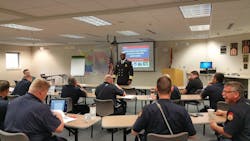Developing and mentoring leaders within the fire service is both a challenging and rewarding process. Unfortunately, little has been done within the fire service to institutionalize the idea that formal mentoring can help our organizations and make future leaders more effective. Without a doubt, mentoring occurs in firehouses across the country; however, when you look at how and why it occurs, it is often because of the dedication of a few company officers and the open-mindedness of some firefighters—not because of anything the department is doing to catalyze the opportunity. A willingness to mentor by experienced members and recognition of the importance of mentoring aren’t our problems. Our problem is that this profession presents complexities that many other occupations don’t have to contend with when looking at future leadership development. These complexities include scheduling, a variety of work locations and a hierarchy that often complicates the process.
It’s about the organization
There are many leadership success stories in the fire service. Most, if not all, of those success stories started with good mentors. Mentoring sometimes has the connotation that it is about the individual. Sometimes, it seems that people perceive the need to mentor as a personal one and not one tied to the organization. If that sentiment is common in your organization’s culture, then it’s time to revisit the entire concept of mentoring and the development of the next generation of leaders. Mentoring should be seen as an essential way to guarantee organizational leadership stamina. If training, experience and education are the building blocks of professional development, then mentoring serves as the mortar. We would never promote someone to a leadership position who lacks the experience, training or education for the position. Similarly, we should not fail to realize that proper mentoring is essential to preparing members for upward advancement.
Mentor for tomorrow
In a profession wrought with stagnation and resistance to change, can we develop future leaders who “see” around corners and construct strategic change? Absolutely. But it requires leaders to understand that we can’t develop future leaders by training them to lead today’s fire departments. Rather, we have to mentor them to lead tomorrow’s fire departments. While some skills stay the same or change only incrementally over time, other skills are emerging and changing at a rapid pace. The opportunity we have to make sure our future leaders understand and hone these skills comes through mentoring.
Getting started
Mentoring can’t reliably exist without some formal, institutionalized process. There is a wide spectrum of variables and opportunities that you can take advantage of to create a mentoring program. Spending some time to determine what is best for your department is essential. Your organizational layout, rank complexity and specific culture are important to the customization of the process.
Regardless of the layout and process, a member within the department must serve as coordinator and facilitator. Their leadership, in addition to formal support from the fire chief, will be essential to accelerating the program and making it productive. Departments should be encouraged to provide training for mentors and protégés alike so that expectations are the same on both sides of the mentoring equation. In much the same way that company officers often exercise influence to assemble an optimal crew that works well together,, the mentoring program coordinator should attempt to match mentors and protégés so that the mentoring process is anchored in an environment with a positive interpersonal dynamic between the two.
Helpful resources
Formal mentoring and leadership development may seem like daunting tasks, but don’t be alarmed or discouraged. Some of the best resources for guiding a formal mentoring process can be found within the Center for Public Safety Excellence’s (CPSE) credentialing program. With Chief Fire Officer, Chief EMS Officer, Fire Officer, Fire Marshal, and Chief Training Officer designations available, much of the criteria are directly applicable to the content of a formal mentoring program. An assessment of a protégé could begin simply by determining their immediate, short-term and long-term career goals. A skills and experience inventory could involve a review of the protégé’s targeted designation, with the mentor and mentoring program coordinator using this information to craft a development plan.
Make the best of what we have
Mentoring and leadership development go hand in hand. We can’t rely on luck to steer the direction of our departments. We have to identify talent, and do our best to mentor it using the tools and resources available.
If done properly, a mentoring program will produce dividends in areas far beyond the protégé. The concept will also signal to all members, regardless of their goals and aspirations, that the department is serious about its future. The process will allow for individual members to bridge generational gaps and potentially increase interdepartmental communication.
TOM JENKINS, MS, CFO, CEMSO, EFO, currently serves as the Fire Chief for the City of Rogers, AR. He holds a Master's of Science degree in Public Administration from the University of Oklahoma and a Bachelor's degree in Fire Protection Engineering from Oklahoma State University. He is the 2nd Vice President of the International Association of Fire Chiefs and has served on numerous national committees and working groups. He is an adjunct professor with Oklahoma State University and Northwest Arkansas Community College. He is a student of the fire profession and a regular presenter at the CPSE Excellence Conference and Fire Rescue International.






